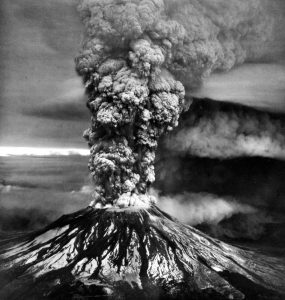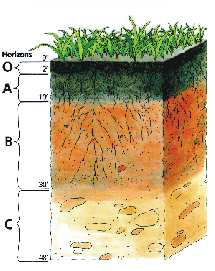Soil geography (pedology)
With ten of the twelve soil orders represented in the state, the diversity of soils types in Washington is renowned. A particular soil type forms in a geographical location due to the interaction of parent material, climate, aspect, vegetation, and time. For example, the highly productive Mollisols of the Palouse hills in eastern Washington formed on wind-blown deposits over tens of thousands of years. The area receives sufficient yearly rain and snow to support remarkable vegetative growth. Before cultivation by settlers, the soils supported vast grasslands that influenced soil development; the grasses added organic matter to the soil and imparted a characteristic dark, humus rich surface horizon. The soils of the Palouse hills vary some with aspect as north-facing slopes accumulate large snowdrifts over the winter and receive less direct sunlight. Mollisols cover large regions of southeastern and central Washington and are also found in some of the Puget Sound lowlands.

Rainfall decreases as one moves west from the eastern edge of the Palouse, resulting in less plant growth and accumulation of organic matter. Soils under cultivation in the western Palouse and Columbian Plateau include Aridisols, light colored desert soils, and Entisols, young soils that lack horizon development. These soils are still quite productive, especially when irrigation is available. Inceptisols are another common agricultural soil in Washington, especially in the western part of the state. Though also young soils they show more horizonation than Entisols. Much of the surface of land surrounding Puget Sound is considered “young” by geologists because it was under thick sheets of ice as recently as 12,000 years ago. Before retreating, these glaciers churned and scarred the land beneath them, leaving behind glacial till, outwash, and lakes. These new surfaces served as the parent material that Puget Sound soils developed on.
The Cascade volcanoes of Oregon and Washington have also affected agricultural soils in Washington. Andisols are soils with a relatively high amount of volcanic material and these soils are also under cultivation in both the Yakima area and in western Washington.
Web soil survey
Soils are stratified vertically into different horizons. Some soils, such as those in forests, have a surface covering of organic matter that transitions into the mineral soil below. The organic layer is called the “O” horizon. The horizon just below that – or in some cases the upper-most horizon – is called the “A” horizon and is also referred to as “topsoil”. It is darker than lower soils because it is enriched in organic matter from plant material that is deposited at the surface.

The “B” and “C” horizons are below the “A” horizon. The “C” horizon consists of partially weathered parent material from which the soil is formed. The “B” horizon receives minerals from the upper horizons as they weather and are leached.
The specific properties of each soil horizon are used to identify the soil found in one location from another and we call a specific type of soil a “soil series.” This is similar to “species” in biology, in that it is a specific name given to a soil. The relationships between the five soil forming factors tend to be unique to different geographical areas and soil series often have geographical names. There are more than 20,000 soil series. In northwestern Washington, for example, some common soil types found on glacial terraces include Lynden, Kickerville, Laxton, and Tromp. In the flood plains, Mt. Vernon or Puyallup are more common.
The Natural Resource Conservation Service has conducted Soil Surveys to map the soils across the country. The Web Soil Survey website has soil survey information on-line that is easily accessible. One can enter their address and then find out what soil series are present at that location. A cell phone app called “SoilWeb” is another way to get this same information. Once the soil series is known, one can find general information about soil properties. For Android or iPhone.
Soil forming factors

Soils are formed by the interaction of five soil forming factors: parent material, climate, organisms, aspect, and time.
As rocks, minerals, and organic matter are chemically and physically weathered they become the parent materials that form soils. Below surface horizons, it is often possible to see unaltered material. Minerals, such as quartz, mica, hornblend, and many others, are solids with a definite chemical composition and ordered atomic arrangement that are formed inorganically. The amount of soil nutrients available will depend on the mineral constituents of the parent material. Some minerals weather more rapidly than others.
Climate affects the speed of weathering for a particular mineral. During the Pleistocene (2-3 million years ago) large glaciers covered most of the north 1/3 of Washington State. The weight and grinding action of glaciers pulverizes the underlying rock and transports and deposits it as parent material. When the Last Glacial Maximum ended 12 to 14 thousand years ago the extent of ice covered ground decreased and new parent material was exposed to soil forming properties.
Above and below-ground organisms also influence soil development. Plants feed soil microbes and stimulate soil development. Aspect influences water and light dynamics. Time is the final soil forming factor. Most soils on Earth are less than 1.65 million years old. Landscapes that were affected by glaciation, as much of Washington State was, have much younger soils – ~ 12,000-14,000 years old. Soils are constantly changing as parent material is weathered through time.